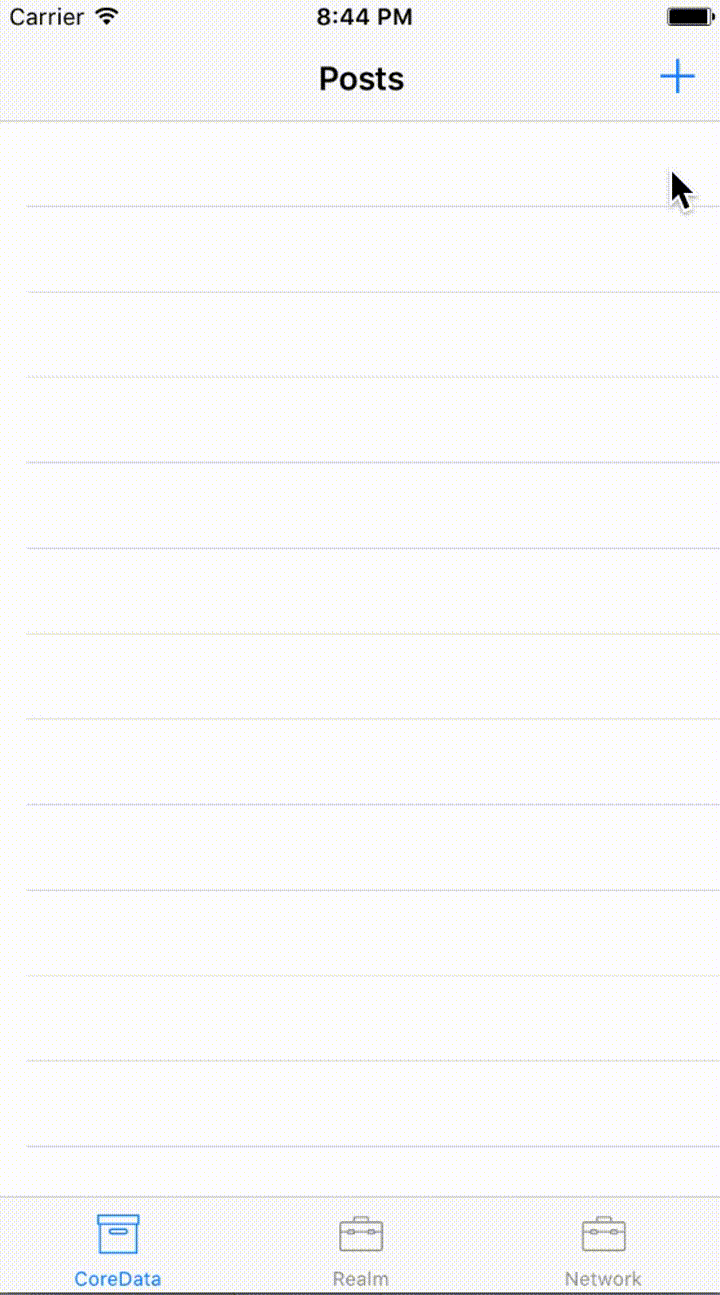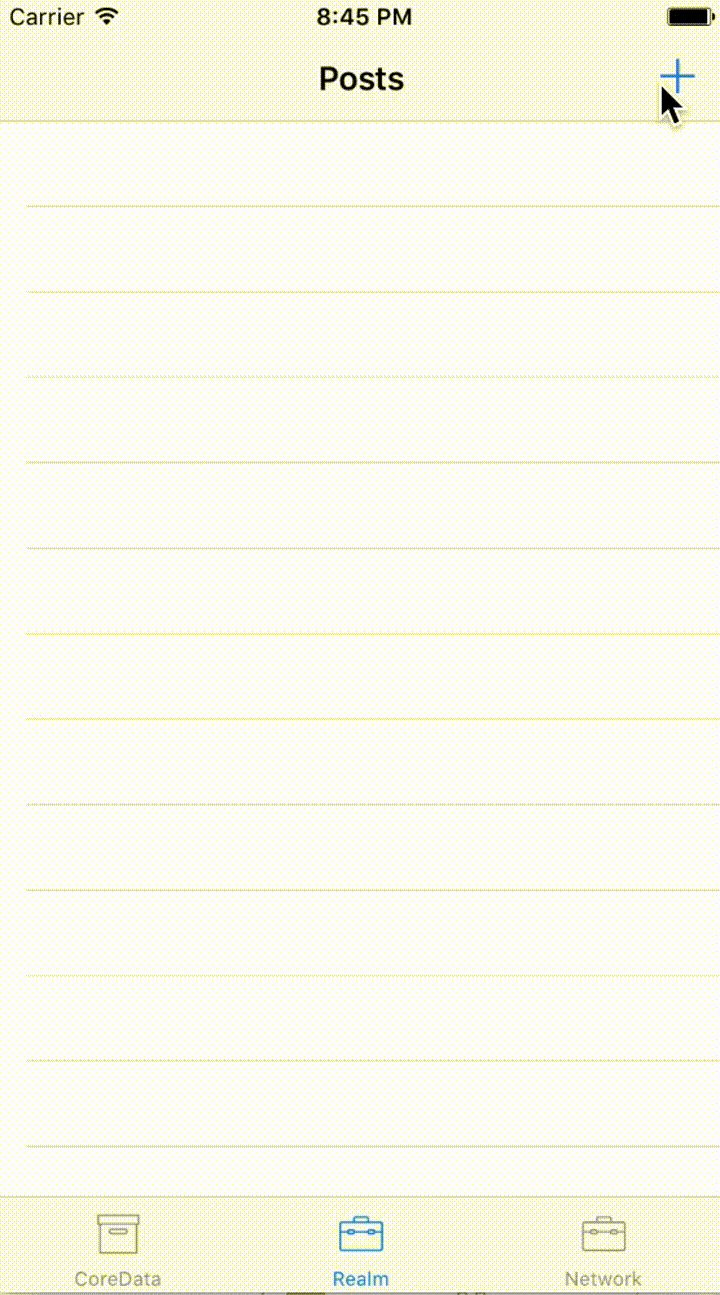Clean architecture with RxSwift
You can do this by:
- opening an issue to discuss the current solution, ask a question, propose your solution etc. (also English is not my native language so if you think that something can be corrected please open a PR 😊)
- opening a PR if you want to fix bugs or improve something
Dependencies in this project are provided via Cocoapods. Please install all dependecies with
pod install
The Domain is basically what is your App about and what it can do (Entities, UseCase etc.) It does not depend on UIKit or any persistence framework, and it doesn't have implementations apart from entities
The Platform is a concrete implementation of the Domain in a specific platform like iOS. It does hide all implementation details. For example Database implementation whether it is CoreData, Realm, SQLite etc.
Application is responsible for delivering information to the user and handling user input. It can be implemented with any delivery pattern e.g (MVVM, MVC, MVP). This is the place for your UIViews and UIViewControllers. As you will see from the example app, ViewControllers are completely independent of the Platform. The only responsibility of a view controller is to "bind" the UI to the Domain to make things happen. In fact, in the current example we are using the same view controller for Realm and CoreData.
To enforce modularity, Domain, Platform and Application are separate targets in the App, which allows us to take advantage of the internal access layer in Swift to prevent exposing of types that we don't want to expose.
Entities are implemented as Swift value types
public struct Post {
public let uid: String
public let createDate: Date
public let updateDate: Date
public let title: String
public let content: String
}UseCases are protocols which do one specific thing:
public protocol PostsUseCase {
func posts() -> Observable<[Post]>
func save(post: Post) -> Observable<Void>
}UseCaseProvider is a service locator. In the current example, it helps to hide the concrete implementation of use cases.
In some cases, we can't use Swift structs for our domain objects because of DB framework requirements (e.g. CoreData, Realm).
final class CDPost: NSManagedObject {
@NSManaged public var uid: String?
@NSManaged public var title: String?
@NSManaged public var content: String?
@NSManaged public var createDate: NSDate?
@NSManaged public var updateDate: NSDate?
}
final class RMPost: Object {
dynamic var uid: String = ""
dynamic var createDate: NSDate = NSDate()
dynamic var updateDate: NSDate = NSDate()
dynamic var title: String = ""
dynamic var content: String = ""
}The Platform also contains concrete implementations of your use cases, repositories or any services that are defined in the Domain.
final class PostsUseCase: Domain.PostsUseCase {
private let repository: AbstractRepository<Post>
init(repository: AbstractRepository<Post>) {
self.repository = repository
}
func posts() -> Observable<[Post]> {
return repository.query(sortDescriptors: [Post.CoreDataType.uid.descending()])
}
func save(post: Post) -> Observable<Void> {
return repository.save(entity: post)
}
}
final class Repository<T: CoreDataRepresentable>: AbstractRepository<T> where T == T.CoreDataType.DomainType {
private let context: NSManagedObjectContext
private let scheduler: ContextScheduler
init(context: NSManagedObjectContext) {
self.context = context
self.scheduler = ContextScheduler(context: context)
}
override func query(with predicate: NSPredicate? = nil,
sortDescriptors: [NSSortDescriptor]? = nil) -> Observable<[T]> {
let request = T.CoreDataType.fetchRequest()
request.predicate = predicate
request.sortDescriptors = sortDescriptors
return context.rx.entities(fetchRequest: request)
.mapToDomain()
.subscribeOn(scheduler)
}
override func save(entity: T) -> Observable<Void> {
return entity.sync(in: context)
.mapToVoid()
.flatMapLatest(context.rx.save)
.subscribeOn(scheduler)
}
}As you can see, concrete implementations are internal, because we don't want to expose our dependecies. The only thing that is exposed in the current example from the Platform is a concrete implementation of the UseCaseProvider.
public final class UseCaseProvider: Domain.UseCaseProvider {
private let coreDataStack = CoreDataStack()
private let postRepository: Repository<Post>
public init() {
postRepository = Repository<Post>(context: coreDataStack.context)
}
public func makePostsUseCase() -> Domain.PostsUseCase {
return PostsUseCase(repository: postRepository)
}
}In the current example, Application is implemented with the MVVM pattern and heavy use of RxSwift, which makes binding very easy.
Where the ViewModel performs pure transformation of a user Input to the Output
protocol ViewModelType {
associatedtype Input
associatedtype Output
func transform(input: Input) -> Output
}final class PostsViewModel: ViewModelType {
struct Input {
let trigger: Driver<Void>
let createPostTrigger: Driver<Void>
let selection: Driver<IndexPath>
}
struct Output {
let fetching: Driver<Bool>
let posts: Driver<[Post]>
let createPost: Driver<Void>
let selectedPost: Driver<Post>
let error: Driver<Error>
}
private let useCase: AllPostsUseCase
private let navigator: PostsNavigator
init(useCase: AllPostsUseCase, navigator: PostsNavigator) {
self.useCase = useCase
self.navigator = navigator
}
func transform(input: Input) -> Output {
......
}
A ViewModel can be injected into a ViewController via property injection or initializer. In the current example, this is done by Navigator.
protocol PostsNavigator {
func toCreatePost()
func toPost(_ post: Post)
func toPosts()
}
class DefaultPostsNavigator: PostsNavigator {
private let storyBoard: UIStoryboard
private let navigationController: UINavigationController
private let services: ServiceLocator
init(services: ServiceLocator,
navigationController: UINavigationController,
storyBoard: UIStoryboard) {
self.services = services
self.navigationController = navigationController
self.storyBoard = storyBoard
}
func toPosts() {
let vc = storyBoard.instantiateViewController(ofType: PostsViewController.self)
vc.viewModel = PostsViewModel(useCase: services.getAllPostsUseCase(),
navigator: self)
navigationController.pushViewController(vc, animated: true)
}
....
}
class PostsViewController: UIViewController {
private let disposeBag = DisposeBag()
var viewModel: PostsViewModel!
...
}The example app is Post/TODOs app which uses Realm, CoreData and Network at the same time as a proof of concept that the Application level is not dependant on the Platform level implementation details.
| CoreData | Realm | Network |
|---|---|---|
 |
 |
 |
The corner stone of Clean Architecture is modularization, as you can hide implementation detail under internal access layer. Further read of this topic here
- ping me on Twitter


